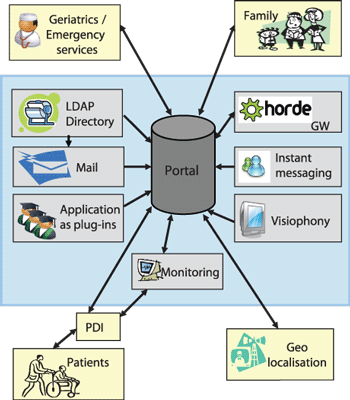The telemedicine platform developed by ESIEE-Paris offers medical and communication services to patients, and is particularly helpful for cases of pre-Alzheimer's disease. It is the result of several telemedicine projects that started in November 2003, like the RNTS (Réseau National Technologies pour la Santé) project TELEPAT and after it, TANDEM. The platform has two main components - a central server and local equipment (PDI - Passerelle Domestique Internet - Domestic Internet Gateway) - that communicate using a secure IP Network over the Internet (VPN).
Population ageing and the financial situation of health services make it quite difficult to satisfy all needs and to maintain the quality of medical care. One method of reducing medical care costs is to reduce the average duration of patient hospitalization, and to reinforce home support by formal (professionals) and informal (familial) caregivers or facilitate home hospitalization. For people who need frequent medical care or constant observation in their everyday life - such as those suffering from cardiac or Alzheimer's diseases, and the frail or elderly - a prolonged stay in a medical centre can result in separation from their entourage. Staying at home is a way to avoid this problem and help the patients maintain their social links.
Advanced functions are under development; these include anti-spam tools for mail, instant messaging filters, improved video quality (for the purpose of using patient television as a visiophony monitor) and robotics management. These developments are scheduled for 2011.
The platform was first designed and set up using standard OpenSource tools (Xen, OpenLDAP, Postfix, Horde GroupWare, jabber and visiophony). This platform is available for two kinds of hardware platform using both Debian Gnu/Linux: Xeon and Itanium-2 processors. The latter offers mathematical capabilities, useful for security and calculation purposes.
The second step was to enhance the critical functions to avoid any mistakes or false positive detection using mathematics tools:
- Hidden Markov Model: the automatic segmentation and classification of ECG data uses statistical approaches such as Hidden Markov Models, derived for sub-beats modelling for ambulatory ECG recordings on the patient. This sensor set constitutes a remote real-time supervision of the patient's cardiac activity at home, and uses a combination of actimetric and health tendency data from the patient that must be correlated with pulse.
- Bayesian statistics: the use of Bayes' theorem for mail body content reduces the amount of spam. The aim is to integrate a tool that gives a spam/ham probability for a message using a phrase-based rather than word-based approach. This tool works as a filter and can also be used for instant messaging.
- Cryptography and relational algebra: to protect confidentiality, the identity and medical data of a patient are split into two sets. The first is stored in an LDAP (Lightweight Directory Access Protocol) directory, using a regular security level. Medical data and the results of cognitive exercises are stored in distributed databases. Only authorized medical personnel can associate identity data to a set of medical results or to an emergency call after a monitoring alarm. The distributed database uses a field authentication scheme not only to avoid external attacks but also to keep multiple levels of confidentiality managed by the LDAP directory.
- Signal processing: for monitoring data, the local base station can perform one or more filtering processes on received signals in order to improve their signal-to-noise ratio and quality, and to estimate the patient's state of health (eg slow or abrupt variations in heart rate to lower the risk of bradycardia). It carries out the fusion of the various physiological and actimetric values in order to calculate an alarm or emergency index, and then retransmits this through a secure VPN link to the remote server of the medical control station.
- Image processing using a Harris detector: with new developments in static video, robotics and augmented reality, the use of this detector will provide the means to detect any changes in a patient's house and then assign rules for robot moves.
- Wavelet transform: a high-quality visiophony service is necessary. For a home-based solution, ad-hoc wireless peripherals are convenient. The use of a motion-compensated spatio-temporal wavelet transform allows the best video quality to be maintained and avoids latency and jitter. A set of optimized algorithms will be deployed on both the server side and the PDI side to improve quality and fluidity. In the near future, an emotion recognition tool will be also implemented.

With two new projects now running (QuoVADis and CompanionAble), this platform will have new functionalities: for instance, a robot (as companion) will be able to help a patient with certain activities such as handling pill boxes, relaying alarms, relaying the voice of an operator or doctor, visualizing the home using augmented reality, emotion recognition and smart home management.
For platform validation, in particular for Alzheimer's patients, the ESIEE-Paris team is working in close cooperation with many partners: with Broca Hospital (Assistance Publique Hopitaux de Paris) for content generation for cognitive stimulation and day-time management as well as ethics, with INT for monitoring and sensors, with private companies like Legrand for smart homes, with University of Reading for project management.
Links:
http://www.esiee.fr
http://www.companionable.net
http://quovadis.ibisc.univ-evry.fr/
Please contact:
Thierry Simonnet
Groupe ESIEE-Paris, France
Tel: +33 1 45 92 66 24
E-mail: t.simonnet![]() esiee.fr
esiee.fr










